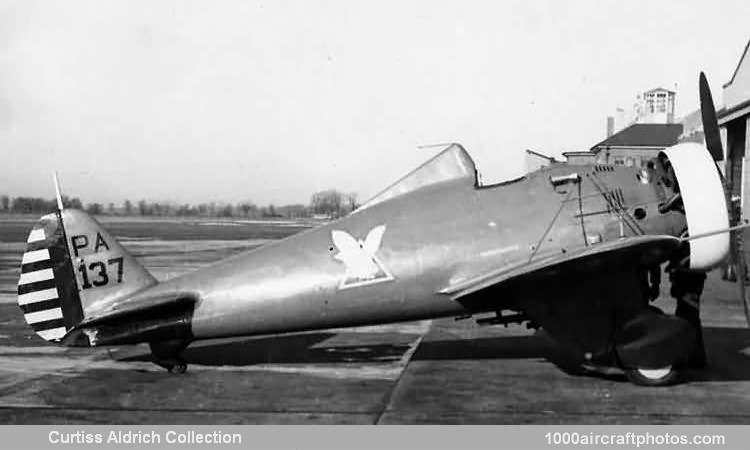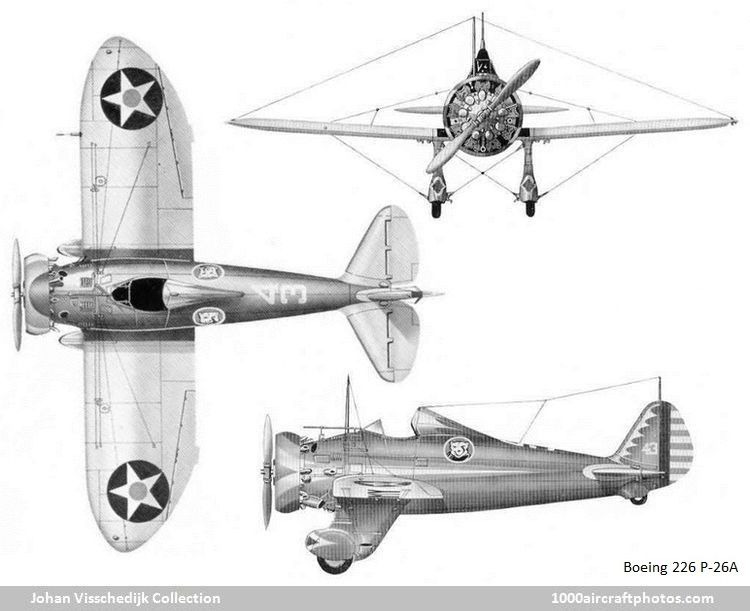12/31/2011. Remarks by Johan Visschedijk: "After testing the XP-936s, the USAAC ordered 111 production versions under the designation of P-26A, c/n 1804 to 1914, s/n 33-28 to 33-138. This was later increased to a total of 136 aircraft, the additional aircraft being completed as P-26B and P-26C.
Outwardly, the P-26A (nicknamed "Peashooter") differed from the prototypes only in that the wheel pants did not project aft of the landing gear strut fairing. Originally, the P-26As had the low, streamlined headrests of the prototypes, but these were soon increased in height by 8 in (0.20 m) for pilot protection after one of the early models went over on its back following a landing on soft ground and killed the pilot without seriously damaging the aircraft.
Inwardly, the P-26A wing structure was considerably revised and such service equipment items as flotation gear and radio were added. The first P-26A made its maiden flight on January 10, 1934, and the last aircraft of the initial order for 111 was delivered on June 30, 1934. After the P-26As were in service, the USAAC became dissatisfied with the relatively high landing speed. Wing flaps, developed and tested by the USAAC on a P-26A and by Boeing on the Model 281, the export version of P-26A, were installed on all P-26As then in service and on the P-26Bs and P-26Cs still in the factory.
All P-26 models had been withdrawn from regular squadron use when WW II began. Most of those stationed overseas were sold to the governments of the Philippines and Panama, and two were sold to Guatemala. One of the Philippine P-26s is credited with shooting down the first Japanese aircraft during the early attacks on the islands. Several of the Panama P-26s were later acquired by Guatemala and were still active in 1955. One was obtained by the Air Museum, now of Ontario, California, where it has been restored to flying condition in its original USAAC markings, and a second was obtained by the US Air Force Museum, Wright-Patterson AFB, Dayton, Ohio.
Twenty-three of the 25 aircraft added to the original order for 111 P-26As were built as P-26C with such slight differences in the fuel and carburetion systems that the factory model number was not changed. The first P-26C was delivered on February 10, 1936, and the last on March 7. After about a year in service, all 23 P-26Cs (c/n 1915, 1917, 1918, 1920 to 1939, s/n 33-181 to 33-203) were converted to P-26B standard by the installation of engines with fuel injection and revision of the fuel system and its controls. However, the factory model designation of the P-26C was not changed and it remained Model 266.
The first two of the 25 aircraft added to the initial P-26A order were completed as Model 266A P-26B. The attendant revisions to the fuel system, plus the fact that the P-26Bs were the first P-26s built with wing flaps as initial equipment, justified a change in the factory model designation. The first P-26B (c/n 1916 s/n 33-179) was delivered to the USAAC on June 20, 1934, and the second (c/n 1919 s/n 33-180) on June 21."

